Tesco Business Operations Management Report - Autumn 2019
VerifiedAdded on 2023/01/18
|12
|3212
|44
Report
AI Summary
This report provides a comprehensive analysis of Tesco's operations management, examining its organizational structure, challenges, and performance objectives. It delves into the application of the 4V model, Gantt charts, and the key processes used in the production and delivery of goods and services. The report critically evaluates the challenges Tesco faces, including competition, globalization, sustainability, and ethical conduct, while also assessing the company's performance objectives such as speed, quality, and flexibility. Furthermore, it explores various production methods like mass and batch production, discussing their pros and cons in meeting performance objectives. The report concludes with recommendations for quality improvements using continuous improvement frameworks to enhance Tesco's overall operational efficiency and effectiveness.
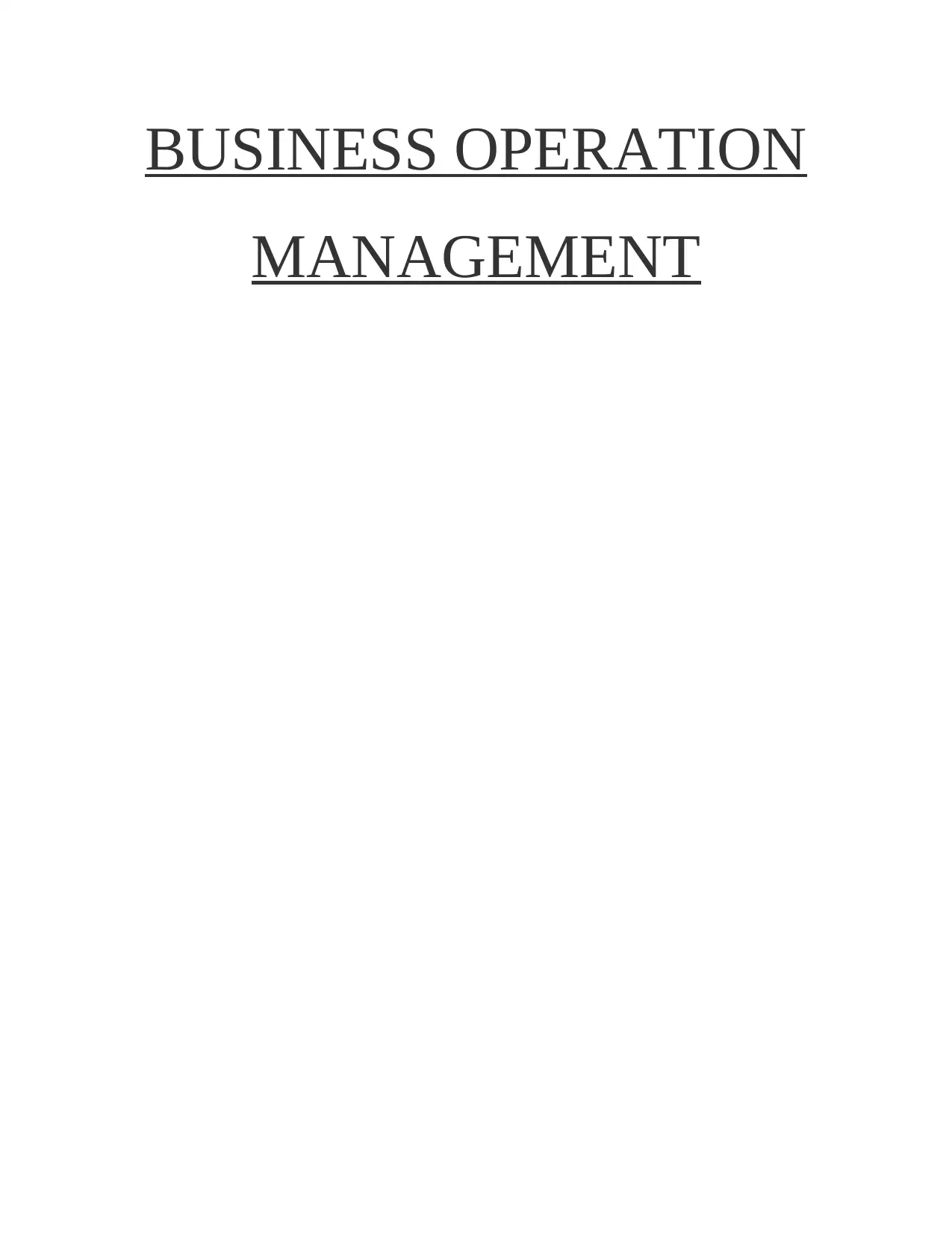
BUSINESS OPERATION
MANAGEMENT
MANAGEMENT
Paraphrase This Document
Need a fresh take? Get an instant paraphrase of this document with our AI Paraphraser
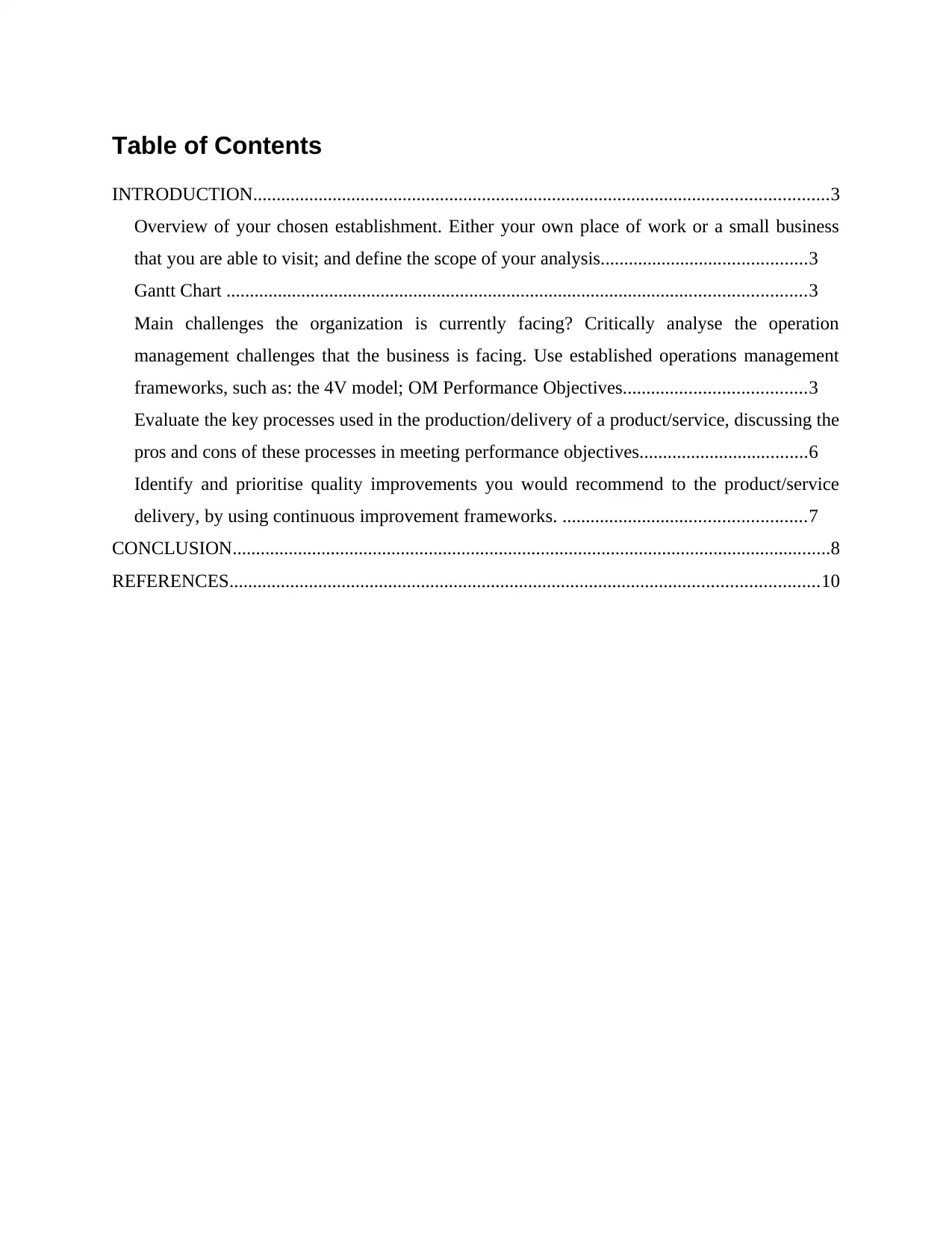
Table of Contents
INTRODUCTION...........................................................................................................................3
Overview of your chosen establishment. Either your own place of work or a small business
that you are able to visit; and define the scope of your analysis............................................3
Gantt Chart ............................................................................................................................3
Main challenges the organization is currently facing? Critically analyse the operation
management challenges that the business is facing. Use established operations management
frameworks, such as: the 4V model; OM Performance Objectives.......................................3
Evaluate the key processes used in the production/delivery of a product/service, discussing the
pros and cons of these processes in meeting performance objectives....................................6
Identify and prioritise quality improvements you would recommend to the product/service
delivery, by using continuous improvement frameworks. ....................................................7
CONCLUSION................................................................................................................................8
REFERENCES..............................................................................................................................10
INTRODUCTION...........................................................................................................................3
Overview of your chosen establishment. Either your own place of work or a small business
that you are able to visit; and define the scope of your analysis............................................3
Gantt Chart ............................................................................................................................3
Main challenges the organization is currently facing? Critically analyse the operation
management challenges that the business is facing. Use established operations management
frameworks, such as: the 4V model; OM Performance Objectives.......................................3
Evaluate the key processes used in the production/delivery of a product/service, discussing the
pros and cons of these processes in meeting performance objectives....................................6
Identify and prioritise quality improvements you would recommend to the product/service
delivery, by using continuous improvement frameworks. ....................................................7
CONCLUSION................................................................................................................................8
REFERENCES..............................................................................................................................10
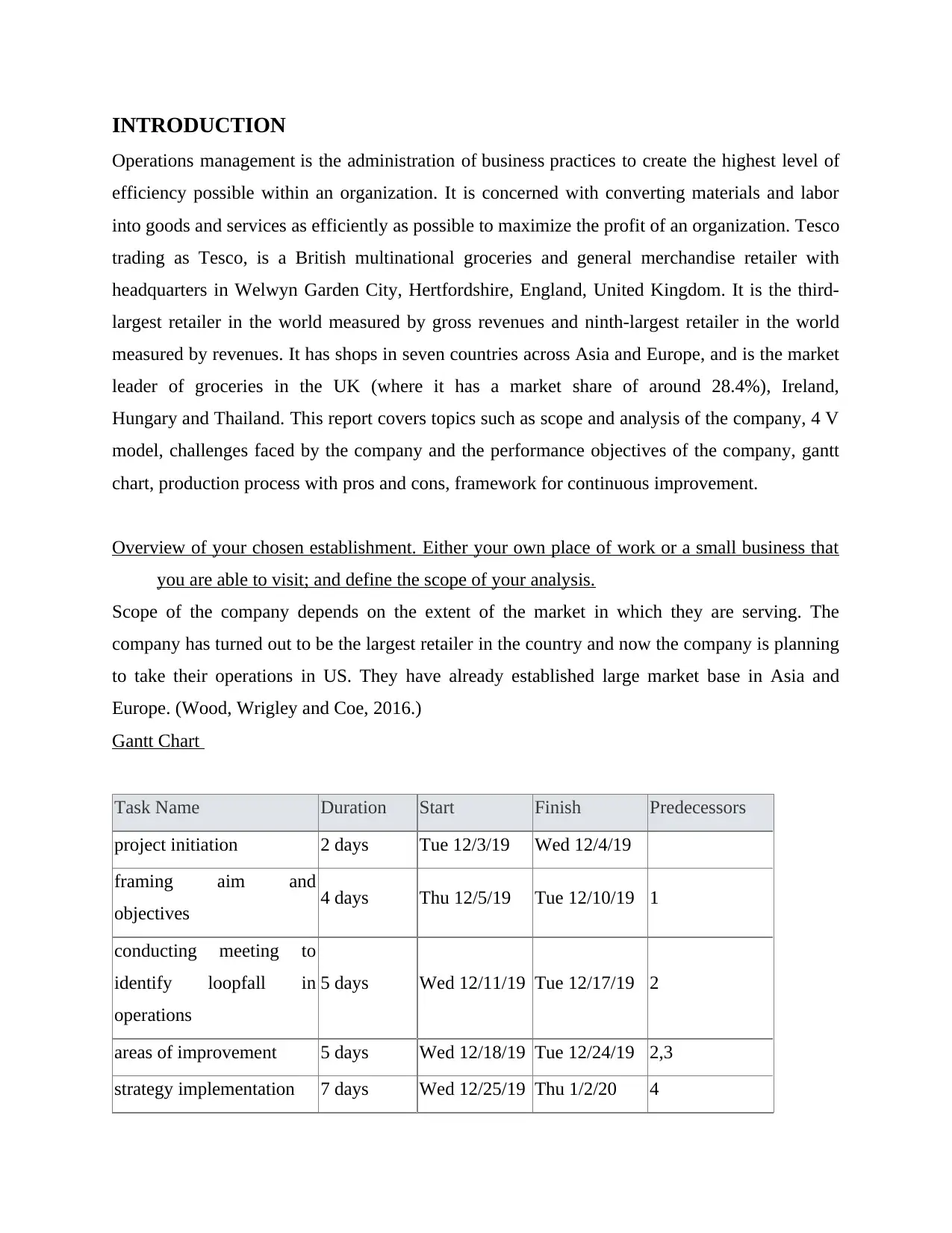
INTRODUCTION
Operations management is the administration of business practices to create the highest level of
efficiency possible within an organization. It is concerned with converting materials and labor
into goods and services as efficiently as possible to maximize the profit of an organization. Tesco
trading as Tesco, is a British multinational groceries and general merchandise retailer with
headquarters in Welwyn Garden City, Hertfordshire, England, United Kingdom. It is the third-
largest retailer in the world measured by gross revenues and ninth-largest retailer in the world
measured by revenues. It has shops in seven countries across Asia and Europe, and is the market
leader of groceries in the UK (where it has a market share of around 28.4%), Ireland,
Hungary and Thailand. This report covers topics such as scope and analysis of the company, 4 V
model, challenges faced by the company and the performance objectives of the company, gantt
chart, production process with pros and cons, framework for continuous improvement.
Overview of your chosen establishment. Either your own place of work or a small business that
you are able to visit; and define the scope of your analysis.
Scope of the company depends on the extent of the market in which they are serving. The
company has turned out to be the largest retailer in the country and now the company is planning
to take their operations in US. They have already established large market base in Asia and
Europe. (Wood, Wrigley and Coe, 2016.)
Gantt Chart
Task Name Duration Start Finish Predecessors
project initiation 2 days Tue 12/3/19 Wed 12/4/19
framing aim and
objectives 4 days Thu 12/5/19 Tue 12/10/19 1
conducting meeting to
identify loopfall in
operations
5 days Wed 12/11/19 Tue 12/17/19 2
areas of improvement 5 days Wed 12/18/19 Tue 12/24/19 2,3
strategy implementation 7 days Wed 12/25/19 Thu 1/2/20 4
Operations management is the administration of business practices to create the highest level of
efficiency possible within an organization. It is concerned with converting materials and labor
into goods and services as efficiently as possible to maximize the profit of an organization. Tesco
trading as Tesco, is a British multinational groceries and general merchandise retailer with
headquarters in Welwyn Garden City, Hertfordshire, England, United Kingdom. It is the third-
largest retailer in the world measured by gross revenues and ninth-largest retailer in the world
measured by revenues. It has shops in seven countries across Asia and Europe, and is the market
leader of groceries in the UK (where it has a market share of around 28.4%), Ireland,
Hungary and Thailand. This report covers topics such as scope and analysis of the company, 4 V
model, challenges faced by the company and the performance objectives of the company, gantt
chart, production process with pros and cons, framework for continuous improvement.
Overview of your chosen establishment. Either your own place of work or a small business that
you are able to visit; and define the scope of your analysis.
Scope of the company depends on the extent of the market in which they are serving. The
company has turned out to be the largest retailer in the country and now the company is planning
to take their operations in US. They have already established large market base in Asia and
Europe. (Wood, Wrigley and Coe, 2016.)
Gantt Chart
Task Name Duration Start Finish Predecessors
project initiation 2 days Tue 12/3/19 Wed 12/4/19
framing aim and
objectives 4 days Thu 12/5/19 Tue 12/10/19 1
conducting meeting to
identify loopfall in
operations
5 days Wed 12/11/19 Tue 12/17/19 2
areas of improvement 5 days Wed 12/18/19 Tue 12/24/19 2,3
strategy implementation 7 days Wed 12/25/19 Thu 1/2/20 4
⊘ This is a preview!⊘
Do you want full access?
Subscribe today to unlock all pages.

Trusted by 1+ million students worldwide
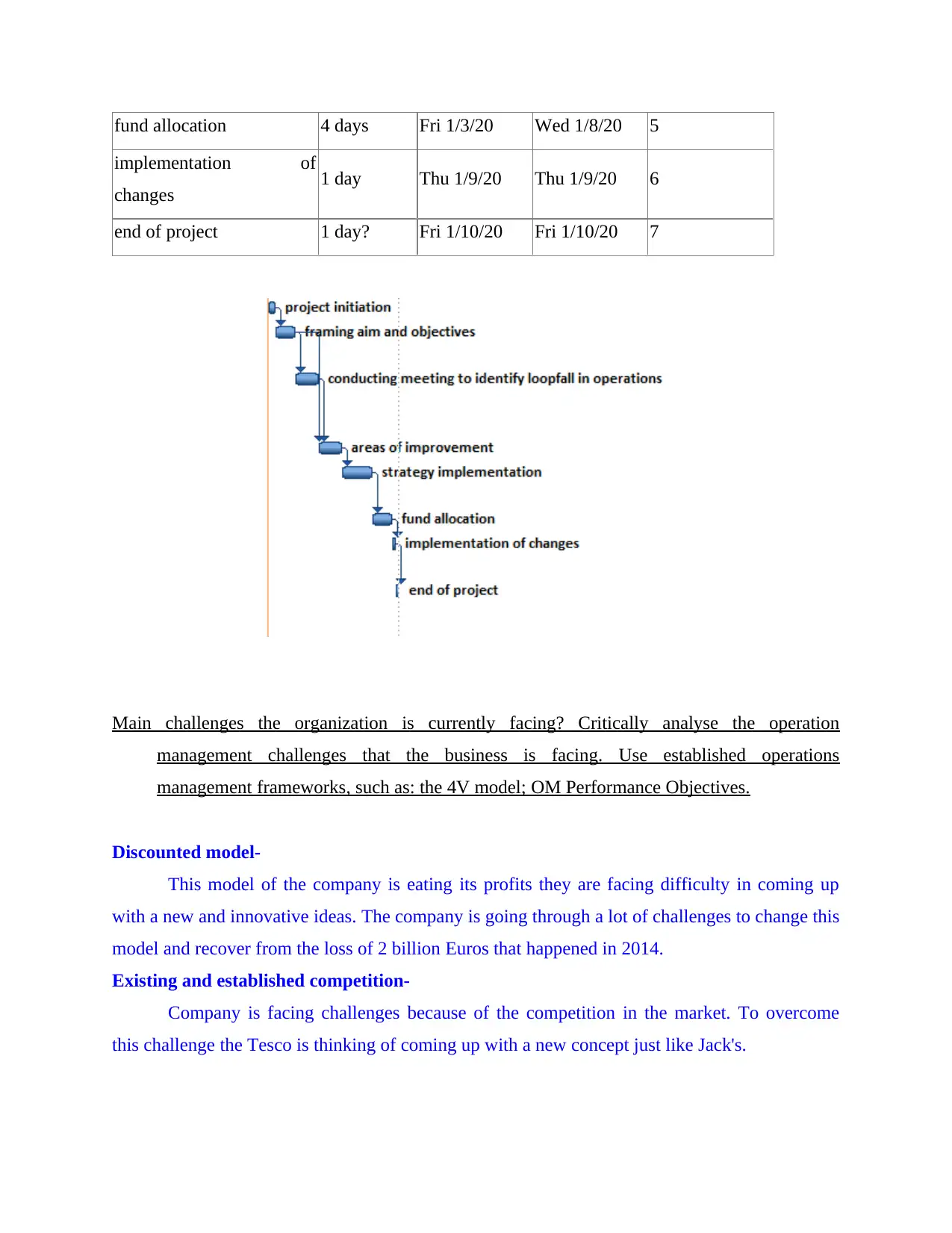
fund allocation 4 days Fri 1/3/20 Wed 1/8/20 5
implementation of
changes 1 day Thu 1/9/20 Thu 1/9/20 6
end of project 1 day? Fri 1/10/20 Fri 1/10/20 7
Main challenges the organization is currently facing? Critically analyse the operation
management challenges that the business is facing. Use established operations
management frameworks, such as: the 4V model; OM Performance Objectives.
Discounted model-
This model of the company is eating its profits they are facing difficulty in coming up
with a new and innovative ideas. The company is going through a lot of challenges to change this
model and recover from the loss of 2 billion Euros that happened in 2014.
Existing and established competition-
Company is facing challenges because of the competition in the market. To overcome
this challenge the Tesco is thinking of coming up with a new concept just like Jack's.
implementation of
changes 1 day Thu 1/9/20 Thu 1/9/20 6
end of project 1 day? Fri 1/10/20 Fri 1/10/20 7
Main challenges the organization is currently facing? Critically analyse the operation
management challenges that the business is facing. Use established operations
management frameworks, such as: the 4V model; OM Performance Objectives.
Discounted model-
This model of the company is eating its profits they are facing difficulty in coming up
with a new and innovative ideas. The company is going through a lot of challenges to change this
model and recover from the loss of 2 billion Euros that happened in 2014.
Existing and established competition-
Company is facing challenges because of the competition in the market. To overcome
this challenge the Tesco is thinking of coming up with a new concept just like Jack's.
Paraphrase This Document
Need a fresh take? Get an instant paraphrase of this document with our AI Paraphraser
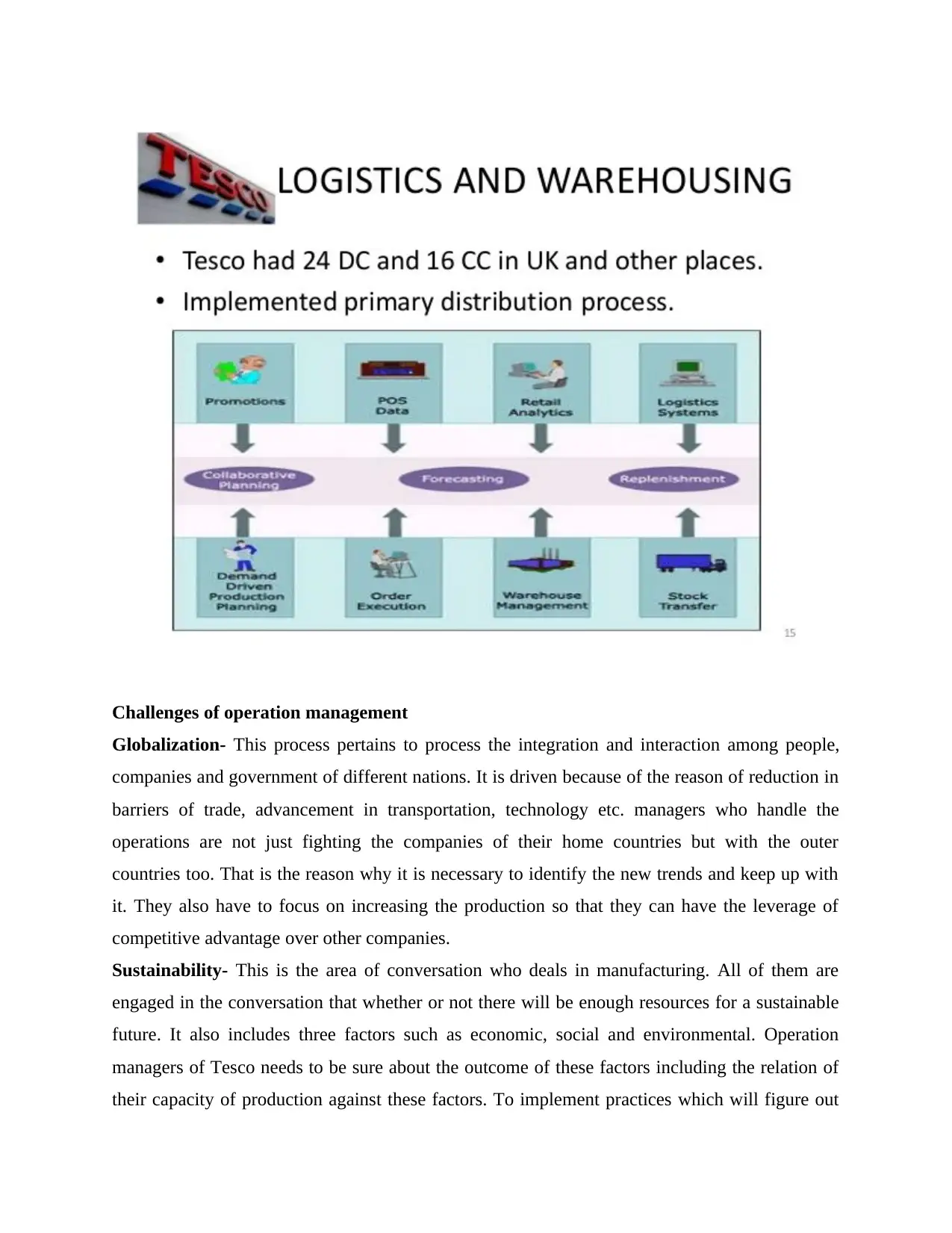
Challenges of operation management
Globalization- This process pertains to process the integration and interaction among people,
companies and government of different nations. It is driven because of the reason of reduction in
barriers of trade, advancement in transportation, technology etc. managers who handle the
operations are not just fighting the companies of their home countries but with the outer
countries too. That is the reason why it is necessary to identify the new trends and keep up with
it. They also have to focus on increasing the production so that they can have the leverage of
competitive advantage over other companies.
Sustainability- This is the area of conversation who deals in manufacturing. All of them are
engaged in the conversation that whether or not there will be enough resources for a sustainable
future. It also includes three factors such as economic, social and environmental. Operation
managers of Tesco needs to be sure about the outcome of these factors including the relation of
their capacity of production against these factors. To implement practices which will figure out
Globalization- This process pertains to process the integration and interaction among people,
companies and government of different nations. It is driven because of the reason of reduction in
barriers of trade, advancement in transportation, technology etc. managers who handle the
operations are not just fighting the companies of their home countries but with the outer
countries too. That is the reason why it is necessary to identify the new trends and keep up with
it. They also have to focus on increasing the production so that they can have the leverage of
competitive advantage over other companies.
Sustainability- This is the area of conversation who deals in manufacturing. All of them are
engaged in the conversation that whether or not there will be enough resources for a sustainable
future. It also includes three factors such as economic, social and environmental. Operation
managers of Tesco needs to be sure about the outcome of these factors including the relation of
their capacity of production against these factors. To implement practices which will figure out
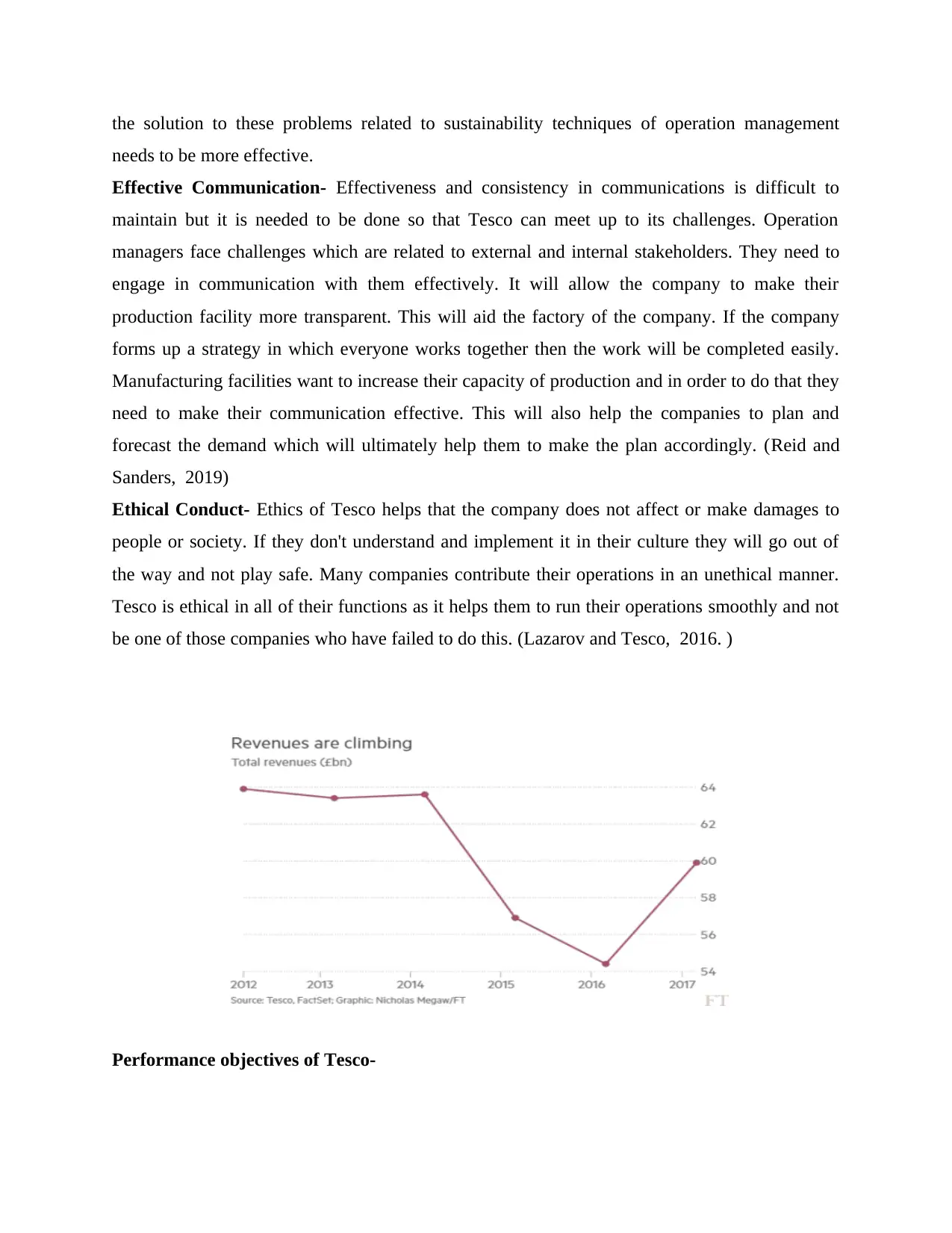
the solution to these problems related to sustainability techniques of operation management
needs to be more effective.
Effective Communication- Effectiveness and consistency in communications is difficult to
maintain but it is needed to be done so that Tesco can meet up to its challenges. Operation
managers face challenges which are related to external and internal stakeholders. They need to
engage in communication with them effectively. It will allow the company to make their
production facility more transparent. This will aid the factory of the company. If the company
forms up a strategy in which everyone works together then the work will be completed easily.
Manufacturing facilities want to increase their capacity of production and in order to do that they
need to make their communication effective. This will also help the companies to plan and
forecast the demand which will ultimately help them to make the plan accordingly. (Reid and
Sanders, 2019)
Ethical Conduct- Ethics of Tesco helps that the company does not affect or make damages to
people or society. If they don't understand and implement it in their culture they will go out of
the way and not play safe. Many companies contribute their operations in an unethical manner.
Tesco is ethical in all of their functions as it helps them to run their operations smoothly and not
be one of those companies who have failed to do this. (Lazarov and Tesco, 2016. )
Performance objectives of Tesco-
needs to be more effective.
Effective Communication- Effectiveness and consistency in communications is difficult to
maintain but it is needed to be done so that Tesco can meet up to its challenges. Operation
managers face challenges which are related to external and internal stakeholders. They need to
engage in communication with them effectively. It will allow the company to make their
production facility more transparent. This will aid the factory of the company. If the company
forms up a strategy in which everyone works together then the work will be completed easily.
Manufacturing facilities want to increase their capacity of production and in order to do that they
need to make their communication effective. This will also help the companies to plan and
forecast the demand which will ultimately help them to make the plan accordingly. (Reid and
Sanders, 2019)
Ethical Conduct- Ethics of Tesco helps that the company does not affect or make damages to
people or society. If they don't understand and implement it in their culture they will go out of
the way and not play safe. Many companies contribute their operations in an unethical manner.
Tesco is ethical in all of their functions as it helps them to run their operations smoothly and not
be one of those companies who have failed to do this. (Lazarov and Tesco, 2016. )
Performance objectives of Tesco-
⊘ This is a preview!⊘
Do you want full access?
Subscribe today to unlock all pages.

Trusted by 1+ million students worldwide
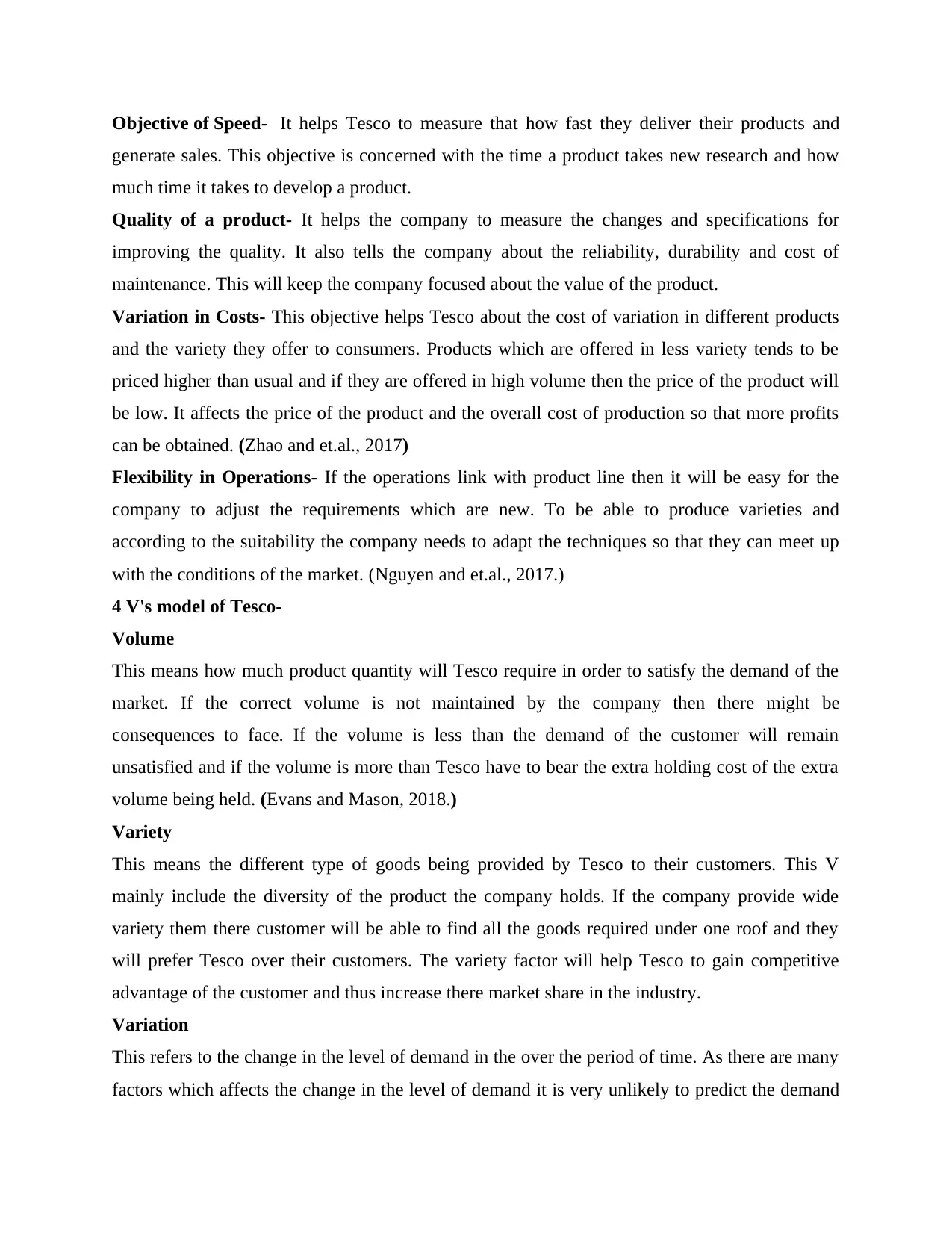
Objective of Speed- It helps Tesco to measure that how fast they deliver their products and
generate sales. This objective is concerned with the time a product takes new research and how
much time it takes to develop a product.
Quality of a product- It helps the company to measure the changes and specifications for
improving the quality. It also tells the company about the reliability, durability and cost of
maintenance. This will keep the company focused about the value of the product.
Variation in Costs- This objective helps Tesco about the cost of variation in different products
and the variety they offer to consumers. Products which are offered in less variety tends to be
priced higher than usual and if they are offered in high volume then the price of the product will
be low. It affects the price of the product and the overall cost of production so that more profits
can be obtained. (Zhao and et.al., 2017)
Flexibility in Operations- If the operations link with product line then it will be easy for the
company to adjust the requirements which are new. To be able to produce varieties and
according to the suitability the company needs to adapt the techniques so that they can meet up
with the conditions of the market. (Nguyen and et.al., 2017.)
4 V's model of Tesco-
Volume
This means how much product quantity will Tesco require in order to satisfy the demand of the
market. If the correct volume is not maintained by the company then there might be
consequences to face. If the volume is less than the demand of the customer will remain
unsatisfied and if the volume is more than Tesco have to bear the extra holding cost of the extra
volume being held. (Evans and Mason, 2018.)
Variety
This means the different type of goods being provided by Tesco to their customers. This V
mainly include the diversity of the product the company holds. If the company provide wide
variety them there customer will be able to find all the goods required under one roof and they
will prefer Tesco over their customers. The variety factor will help Tesco to gain competitive
advantage of the customer and thus increase there market share in the industry.
Variation
This refers to the change in the level of demand in the over the period of time. As there are many
factors which affects the change in the level of demand it is very unlikely to predict the demand
generate sales. This objective is concerned with the time a product takes new research and how
much time it takes to develop a product.
Quality of a product- It helps the company to measure the changes and specifications for
improving the quality. It also tells the company about the reliability, durability and cost of
maintenance. This will keep the company focused about the value of the product.
Variation in Costs- This objective helps Tesco about the cost of variation in different products
and the variety they offer to consumers. Products which are offered in less variety tends to be
priced higher than usual and if they are offered in high volume then the price of the product will
be low. It affects the price of the product and the overall cost of production so that more profits
can be obtained. (Zhao and et.al., 2017)
Flexibility in Operations- If the operations link with product line then it will be easy for the
company to adjust the requirements which are new. To be able to produce varieties and
according to the suitability the company needs to adapt the techniques so that they can meet up
with the conditions of the market. (Nguyen and et.al., 2017.)
4 V's model of Tesco-
Volume
This means how much product quantity will Tesco require in order to satisfy the demand of the
market. If the correct volume is not maintained by the company then there might be
consequences to face. If the volume is less than the demand of the customer will remain
unsatisfied and if the volume is more than Tesco have to bear the extra holding cost of the extra
volume being held. (Evans and Mason, 2018.)
Variety
This means the different type of goods being provided by Tesco to their customers. This V
mainly include the diversity of the product the company holds. If the company provide wide
variety them there customer will be able to find all the goods required under one roof and they
will prefer Tesco over their customers. The variety factor will help Tesco to gain competitive
advantage of the customer and thus increase there market share in the industry.
Variation
This refers to the change in the level of demand in the over the period of time. As there are many
factors which affects the change in the level of demand it is very unlikely to predict the demand
Paraphrase This Document
Need a fresh take? Get an instant paraphrase of this document with our AI Paraphraser
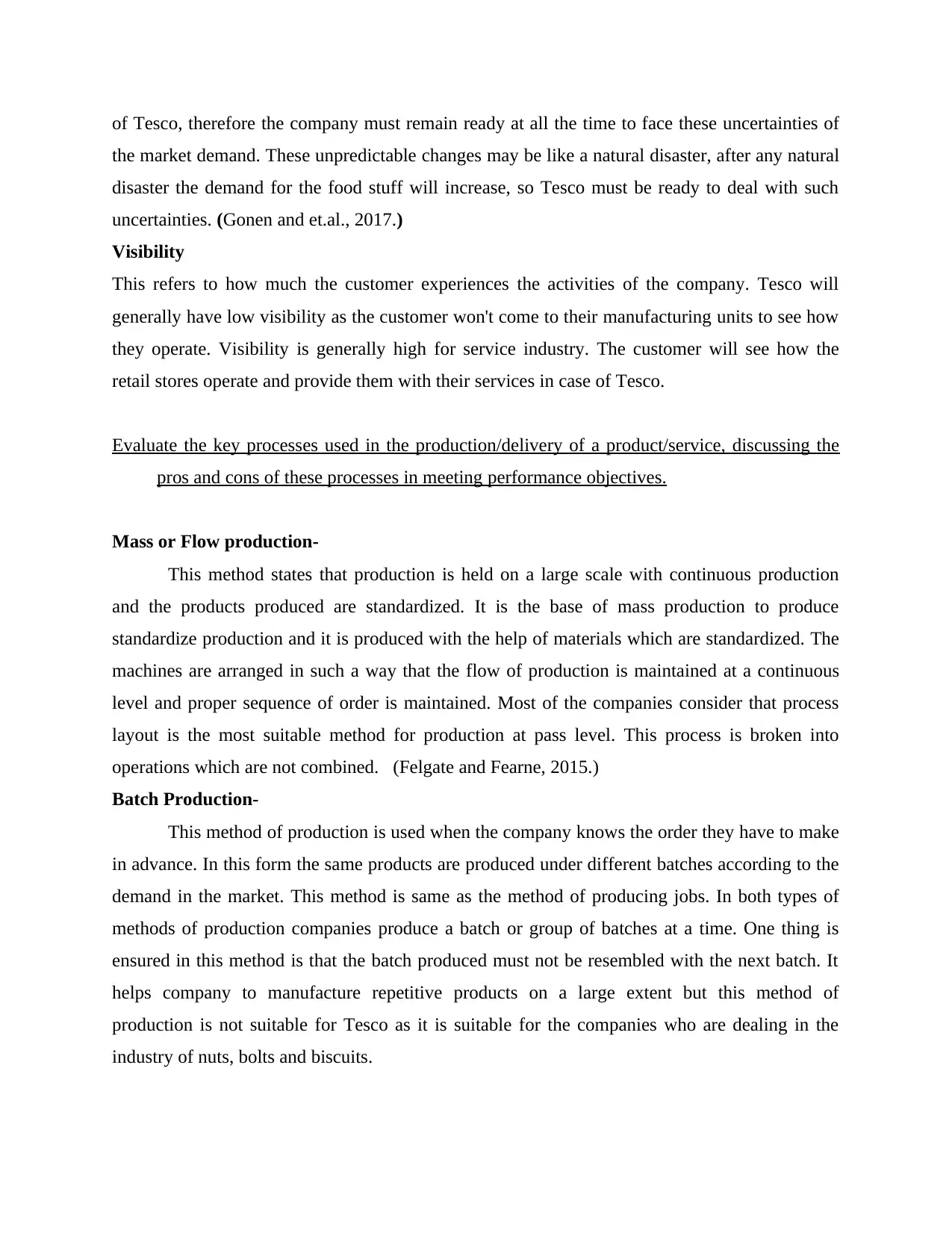
of Tesco, therefore the company must remain ready at all the time to face these uncertainties of
the market demand. These unpredictable changes may be like a natural disaster, after any natural
disaster the demand for the food stuff will increase, so Tesco must be ready to deal with such
uncertainties. (Gonen and et.al., 2017.)
Visibility
This refers to how much the customer experiences the activities of the company. Tesco will
generally have low visibility as the customer won't come to their manufacturing units to see how
they operate. Visibility is generally high for service industry. The customer will see how the
retail stores operate and provide them with their services in case of Tesco.
Evaluate the key processes used in the production/delivery of a product/service, discussing the
pros and cons of these processes in meeting performance objectives.
Mass or Flow production-
This method states that production is held on a large scale with continuous production
and the products produced are standardized. It is the base of mass production to produce
standardize production and it is produced with the help of materials which are standardized. The
machines are arranged in such a way that the flow of production is maintained at a continuous
level and proper sequence of order is maintained. Most of the companies consider that process
layout is the most suitable method for production at pass level. This process is broken into
operations which are not combined. (Felgate and Fearne, 2015.)
Batch Production-
This method of production is used when the company knows the order they have to make
in advance. In this form the same products are produced under different batches according to the
demand in the market. This method is same as the method of producing jobs. In both types of
methods of production companies produce a batch or group of batches at a time. One thing is
ensured in this method is that the batch produced must not be resembled with the next batch. It
helps company to manufacture repetitive products on a large extent but this method of
production is not suitable for Tesco as it is suitable for the companies who are dealing in the
industry of nuts, bolts and biscuits.
the market demand. These unpredictable changes may be like a natural disaster, after any natural
disaster the demand for the food stuff will increase, so Tesco must be ready to deal with such
uncertainties. (Gonen and et.al., 2017.)
Visibility
This refers to how much the customer experiences the activities of the company. Tesco will
generally have low visibility as the customer won't come to their manufacturing units to see how
they operate. Visibility is generally high for service industry. The customer will see how the
retail stores operate and provide them with their services in case of Tesco.
Evaluate the key processes used in the production/delivery of a product/service, discussing the
pros and cons of these processes in meeting performance objectives.
Mass or Flow production-
This method states that production is held on a large scale with continuous production
and the products produced are standardized. It is the base of mass production to produce
standardize production and it is produced with the help of materials which are standardized. The
machines are arranged in such a way that the flow of production is maintained at a continuous
level and proper sequence of order is maintained. Most of the companies consider that process
layout is the most suitable method for production at pass level. This process is broken into
operations which are not combined. (Felgate and Fearne, 2015.)
Batch Production-
This method of production is used when the company knows the order they have to make
in advance. In this form the same products are produced under different batches according to the
demand in the market. This method is same as the method of producing jobs. In both types of
methods of production companies produce a batch or group of batches at a time. One thing is
ensured in this method is that the batch produced must not be resembled with the next batch. It
helps company to manufacture repetitive products on a large extent but this method of
production is not suitable for Tesco as it is suitable for the companies who are dealing in the
industry of nuts, bolts and biscuits.
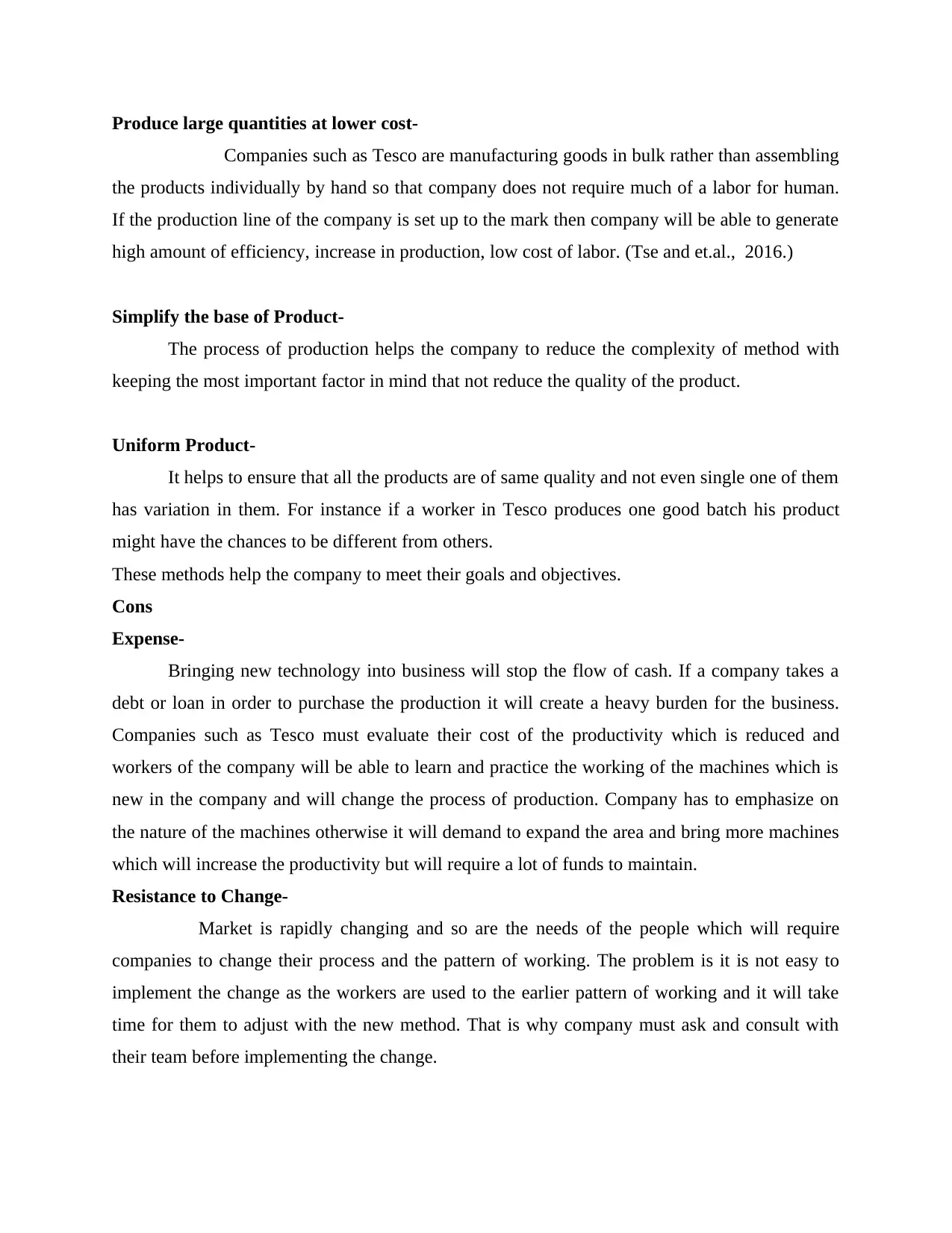
Produce large quantities at lower cost-
Companies such as Tesco are manufacturing goods in bulk rather than assembling
the products individually by hand so that company does not require much of a labor for human.
If the production line of the company is set up to the mark then company will be able to generate
high amount of efficiency, increase in production, low cost of labor. (Tse and et.al., 2016.)
Simplify the base of Product-
The process of production helps the company to reduce the complexity of method with
keeping the most important factor in mind that not reduce the quality of the product.
Uniform Product-
It helps to ensure that all the products are of same quality and not even single one of them
has variation in them. For instance if a worker in Tesco produces one good batch his product
might have the chances to be different from others.
These methods help the company to meet their goals and objectives.
Cons
Expense-
Bringing new technology into business will stop the flow of cash. If a company takes a
debt or loan in order to purchase the production it will create a heavy burden for the business.
Companies such as Tesco must evaluate their cost of the productivity which is reduced and
workers of the company will be able to learn and practice the working of the machines which is
new in the company and will change the process of production. Company has to emphasize on
the nature of the machines otherwise it will demand to expand the area and bring more machines
which will increase the productivity but will require a lot of funds to maintain.
Resistance to Change-
Market is rapidly changing and so are the needs of the people which will require
companies to change their process and the pattern of working. The problem is it is not easy to
implement the change as the workers are used to the earlier pattern of working and it will take
time for them to adjust with the new method. That is why company must ask and consult with
their team before implementing the change.
Companies such as Tesco are manufacturing goods in bulk rather than assembling
the products individually by hand so that company does not require much of a labor for human.
If the production line of the company is set up to the mark then company will be able to generate
high amount of efficiency, increase in production, low cost of labor. (Tse and et.al., 2016.)
Simplify the base of Product-
The process of production helps the company to reduce the complexity of method with
keeping the most important factor in mind that not reduce the quality of the product.
Uniform Product-
It helps to ensure that all the products are of same quality and not even single one of them
has variation in them. For instance if a worker in Tesco produces one good batch his product
might have the chances to be different from others.
These methods help the company to meet their goals and objectives.
Cons
Expense-
Bringing new technology into business will stop the flow of cash. If a company takes a
debt or loan in order to purchase the production it will create a heavy burden for the business.
Companies such as Tesco must evaluate their cost of the productivity which is reduced and
workers of the company will be able to learn and practice the working of the machines which is
new in the company and will change the process of production. Company has to emphasize on
the nature of the machines otherwise it will demand to expand the area and bring more machines
which will increase the productivity but will require a lot of funds to maintain.
Resistance to Change-
Market is rapidly changing and so are the needs of the people which will require
companies to change their process and the pattern of working. The problem is it is not easy to
implement the change as the workers are used to the earlier pattern of working and it will take
time for them to adjust with the new method. That is why company must ask and consult with
their team before implementing the change.
⊘ This is a preview!⊘
Do you want full access?
Subscribe today to unlock all pages.

Trusted by 1+ million students worldwide
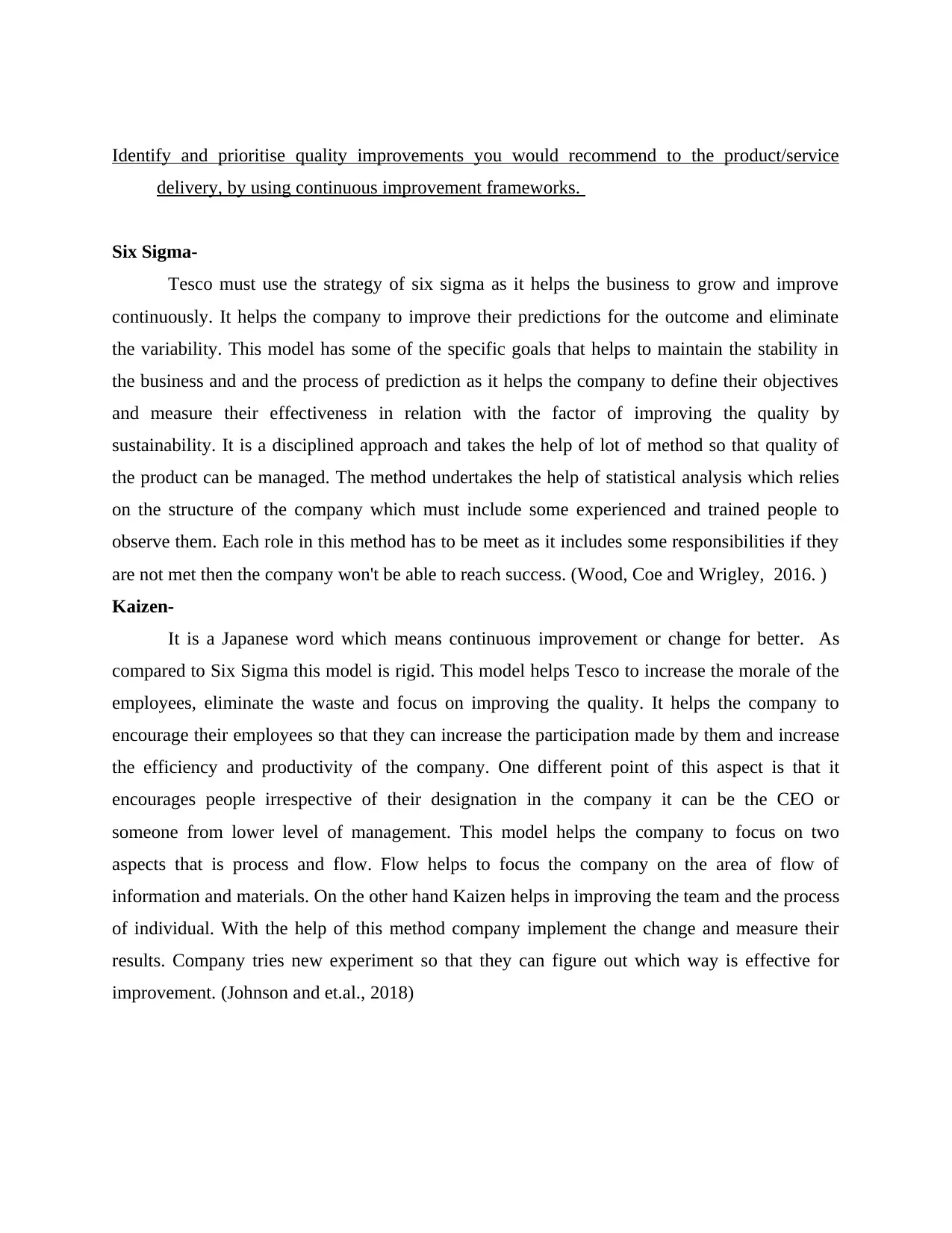
Identify and prioritise quality improvements you would recommend to the product/service
delivery, by using continuous improvement frameworks.
Six Sigma-
Tesco must use the strategy of six sigma as it helps the business to grow and improve
continuously. It helps the company to improve their predictions for the outcome and eliminate
the variability. This model has some of the specific goals that helps to maintain the stability in
the business and and the process of prediction as it helps the company to define their objectives
and measure their effectiveness in relation with the factor of improving the quality by
sustainability. It is a disciplined approach and takes the help of lot of method so that quality of
the product can be managed. The method undertakes the help of statistical analysis which relies
on the structure of the company which must include some experienced and trained people to
observe them. Each role in this method has to be meet as it includes some responsibilities if they
are not met then the company won't be able to reach success. (Wood, Coe and Wrigley, 2016. )
Kaizen-
It is a Japanese word which means continuous improvement or change for better. As
compared to Six Sigma this model is rigid. This model helps Tesco to increase the morale of the
employees, eliminate the waste and focus on improving the quality. It helps the company to
encourage their employees so that they can increase the participation made by them and increase
the efficiency and productivity of the company. One different point of this aspect is that it
encourages people irrespective of their designation in the company it can be the CEO or
someone from lower level of management. This model helps the company to focus on two
aspects that is process and flow. Flow helps to focus the company on the area of flow of
information and materials. On the other hand Kaizen helps in improving the team and the process
of individual. With the help of this method company implement the change and measure their
results. Company tries new experiment so that they can figure out which way is effective for
improvement. (Johnson and et.al., 2018)
delivery, by using continuous improvement frameworks.
Six Sigma-
Tesco must use the strategy of six sigma as it helps the business to grow and improve
continuously. It helps the company to improve their predictions for the outcome and eliminate
the variability. This model has some of the specific goals that helps to maintain the stability in
the business and and the process of prediction as it helps the company to define their objectives
and measure their effectiveness in relation with the factor of improving the quality by
sustainability. It is a disciplined approach and takes the help of lot of method so that quality of
the product can be managed. The method undertakes the help of statistical analysis which relies
on the structure of the company which must include some experienced and trained people to
observe them. Each role in this method has to be meet as it includes some responsibilities if they
are not met then the company won't be able to reach success. (Wood, Coe and Wrigley, 2016. )
Kaizen-
It is a Japanese word which means continuous improvement or change for better. As
compared to Six Sigma this model is rigid. This model helps Tesco to increase the morale of the
employees, eliminate the waste and focus on improving the quality. It helps the company to
encourage their employees so that they can increase the participation made by them and increase
the efficiency and productivity of the company. One different point of this aspect is that it
encourages people irrespective of their designation in the company it can be the CEO or
someone from lower level of management. This model helps the company to focus on two
aspects that is process and flow. Flow helps to focus the company on the area of flow of
information and materials. On the other hand Kaizen helps in improving the team and the process
of individual. With the help of this method company implement the change and measure their
results. Company tries new experiment so that they can figure out which way is effective for
improvement. (Johnson and et.al., 2018)
Paraphrase This Document
Need a fresh take? Get an instant paraphrase of this document with our AI Paraphraser
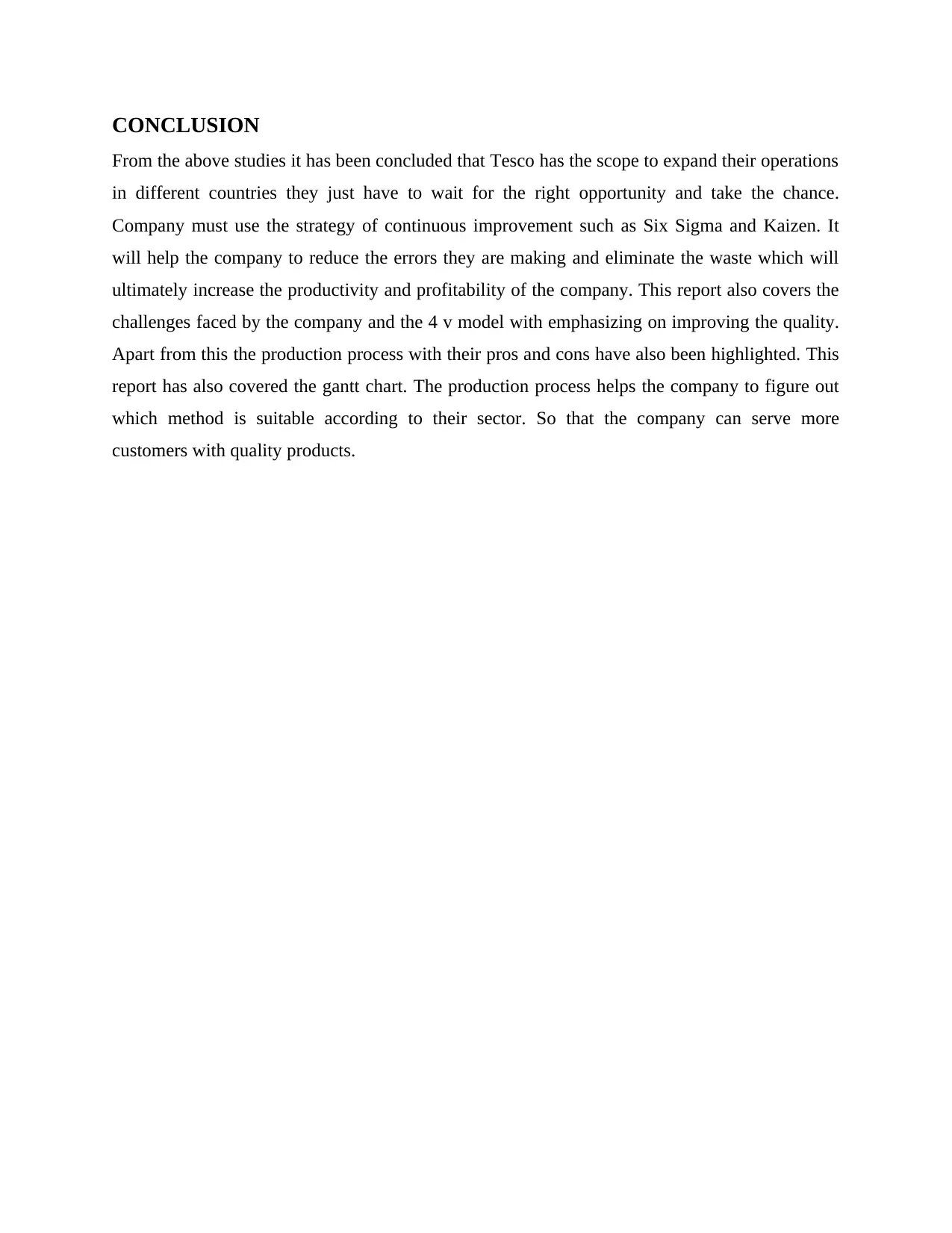
CONCLUSION
From the above studies it has been concluded that Tesco has the scope to expand their operations
in different countries they just have to wait for the right opportunity and take the chance.
Company must use the strategy of continuous improvement such as Six Sigma and Kaizen. It
will help the company to reduce the errors they are making and eliminate the waste which will
ultimately increase the productivity and profitability of the company. This report also covers the
challenges faced by the company and the 4 v model with emphasizing on improving the quality.
Apart from this the production process with their pros and cons have also been highlighted. This
report has also covered the gantt chart. The production process helps the company to figure out
which method is suitable according to their sector. So that the company can serve more
customers with quality products.
From the above studies it has been concluded that Tesco has the scope to expand their operations
in different countries they just have to wait for the right opportunity and take the chance.
Company must use the strategy of continuous improvement such as Six Sigma and Kaizen. It
will help the company to reduce the errors they are making and eliminate the waste which will
ultimately increase the productivity and profitability of the company. This report also covers the
challenges faced by the company and the 4 v model with emphasizing on improving the quality.
Apart from this the production process with their pros and cons have also been highlighted. This
report has also covered the gantt chart. The production process helps the company to figure out
which method is suitable according to their sector. So that the company can serve more
customers with quality products.
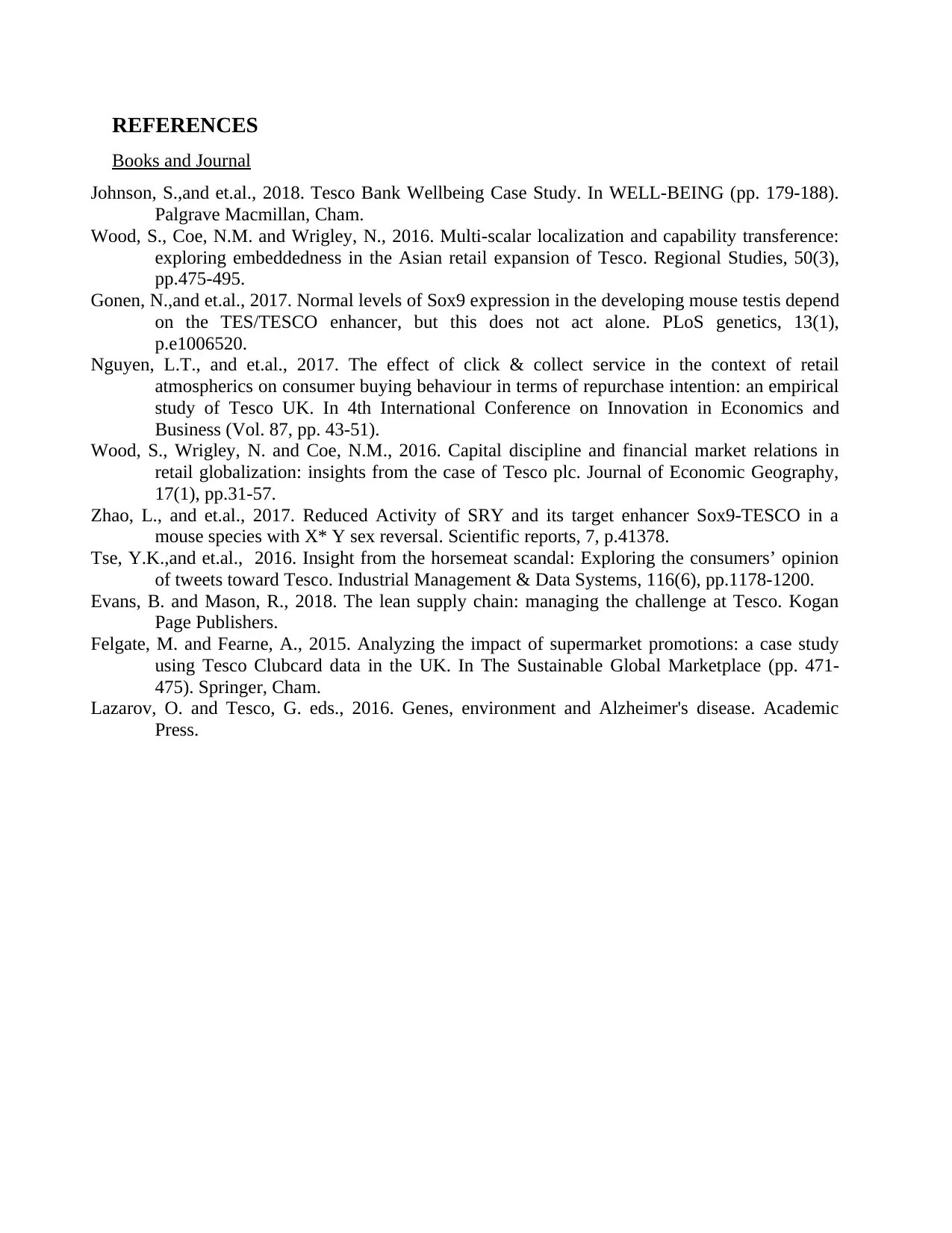
REFERENCES
Books and Journal
Johnson, S.,and et.al., 2018. Tesco Bank Wellbeing Case Study. In WELL-BEING (pp. 179-188).
Palgrave Macmillan, Cham.
Wood, S., Coe, N.M. and Wrigley, N., 2016. Multi-scalar localization and capability transference:
exploring embeddedness in the Asian retail expansion of Tesco. Regional Studies, 50(3),
pp.475-495.
Gonen, N.,and et.al., 2017. Normal levels of Sox9 expression in the developing mouse testis depend
on the TES/TESCO enhancer, but this does not act alone. PLoS genetics, 13(1),
p.e1006520.
Nguyen, L.T., and et.al., 2017. The effect of click & collect service in the context of retail
atmospherics on consumer buying behaviour in terms of repurchase intention: an empirical
study of Tesco UK. In 4th International Conference on Innovation in Economics and
Business (Vol. 87, pp. 43-51).
Wood, S., Wrigley, N. and Coe, N.M., 2016. Capital discipline and financial market relations in
retail globalization: insights from the case of Tesco plc. Journal of Economic Geography,
17(1), pp.31-57.
Zhao, L., and et.al., 2017. Reduced Activity of SRY and its target enhancer Sox9-TESCO in a
mouse species with X* Y sex reversal. Scientific reports, 7, p.41378.
Tse, Y.K.,and et.al., 2016. Insight from the horsemeat scandal: Exploring the consumers’ opinion
of tweets toward Tesco. Industrial Management & Data Systems, 116(6), pp.1178-1200.
Evans, B. and Mason, R., 2018. The lean supply chain: managing the challenge at Tesco. Kogan
Page Publishers.
Felgate, M. and Fearne, A., 2015. Analyzing the impact of supermarket promotions: a case study
using Tesco Clubcard data in the UK. In The Sustainable Global Marketplace (pp. 471-
475). Springer, Cham.
Lazarov, O. and Tesco, G. eds., 2016. Genes, environment and Alzheimer's disease. Academic
Press.
Books and Journal
Johnson, S.,and et.al., 2018. Tesco Bank Wellbeing Case Study. In WELL-BEING (pp. 179-188).
Palgrave Macmillan, Cham.
Wood, S., Coe, N.M. and Wrigley, N., 2016. Multi-scalar localization and capability transference:
exploring embeddedness in the Asian retail expansion of Tesco. Regional Studies, 50(3),
pp.475-495.
Gonen, N.,and et.al., 2017. Normal levels of Sox9 expression in the developing mouse testis depend
on the TES/TESCO enhancer, but this does not act alone. PLoS genetics, 13(1),
p.e1006520.
Nguyen, L.T., and et.al., 2017. The effect of click & collect service in the context of retail
atmospherics on consumer buying behaviour in terms of repurchase intention: an empirical
study of Tesco UK. In 4th International Conference on Innovation in Economics and
Business (Vol. 87, pp. 43-51).
Wood, S., Wrigley, N. and Coe, N.M., 2016. Capital discipline and financial market relations in
retail globalization: insights from the case of Tesco plc. Journal of Economic Geography,
17(1), pp.31-57.
Zhao, L., and et.al., 2017. Reduced Activity of SRY and its target enhancer Sox9-TESCO in a
mouse species with X* Y sex reversal. Scientific reports, 7, p.41378.
Tse, Y.K.,and et.al., 2016. Insight from the horsemeat scandal: Exploring the consumers’ opinion
of tweets toward Tesco. Industrial Management & Data Systems, 116(6), pp.1178-1200.
Evans, B. and Mason, R., 2018. The lean supply chain: managing the challenge at Tesco. Kogan
Page Publishers.
Felgate, M. and Fearne, A., 2015. Analyzing the impact of supermarket promotions: a case study
using Tesco Clubcard data in the UK. In The Sustainable Global Marketplace (pp. 471-
475). Springer, Cham.
Lazarov, O. and Tesco, G. eds., 2016. Genes, environment and Alzheimer's disease. Academic
Press.
⊘ This is a preview!⊘
Do you want full access?
Subscribe today to unlock all pages.

Trusted by 1+ million students worldwide
1 out of 12
Related Documents
Your All-in-One AI-Powered Toolkit for Academic Success.
+13062052269
info@desklib.com
Available 24*7 on WhatsApp / Email
![[object Object]](/_next/static/media/star-bottom.7253800d.svg)
Unlock your academic potential
Copyright © 2020–2025 A2Z Services. All Rights Reserved. Developed and managed by ZUCOL.

![[University Name] Internet Marketing Project: Gantt Chart & Details](/_next/image/?url=https%3A%2F%2Fdesklib.com%2Fmedia%2Fimages%2Fek%2F209c9f71e1f74472a5fc76b3d2e9d82d.jpg&w=256&q=75)


